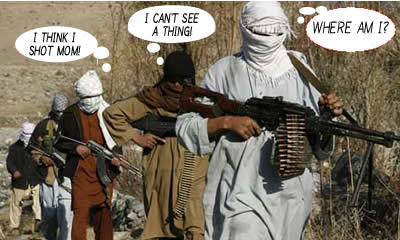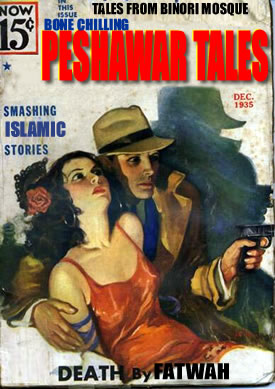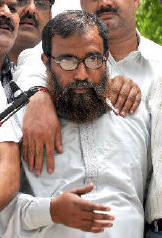The development comes as terrorism is again rearing its head in the country, especially in Khyber-Pakhtunkhwa and Balochistan
...the Pak province bordering Kandahar and Uruzgun provinces in Afghanistan and Sistan Baluchistan in Iran. Its native Baloch propulation is being displaced by Pashtuns and Punjabis and they aren't happy about it...
Pakistain has seen a rise in terrorist attacks across the country, believed to have been planned and directed by the outlawed Tehrik-e-Taliban
 ...mindless ferocity in a turban...
...mindless ferocity in a turban...Pakistain (TTP) leaders based in Afghanistan.
The TTP, which has ideological linkages with the Afghan Taliban, executed more than 100 attacks last year, most of which happened after August when the group’s peace talks with the Pakistain government began to falter. The ceasefire was formally ended last year on Nov 28 by the TTP.
The 14-page fatwa, a copy of which is available with Dawn.com, has been signed by 16 religious scholars from difference schools of thought, including Maulana Qari Ehsanul Haq, Mufti Subhanallah Jan, Dr Maulana Attaur Rehman, Maulana Hussain Ahmed, Maulana Dr Abdul Nasir, Mufti Mukhtarullah Haqqani, Maulana Tayyab Qureshi, Maulana Salmanul Haq Haqqani, Maulana Rehmatullah Qadri, Maulana Umar bin Abdul Aziz, Allama Abid Hussain Shakri, Mufti Mairajul Din Sarkani, Mufti Raza Mohammad Haqqani, Mufti Khalid Usmani, Mufti Sheikh Aijaz and Maulana Abdul Kareem.
KP Chief Khateeb Maulana Tayyab Qureshi, one of the signatories, said the Learned Elders of Islam had issued the fatwa to answer some questions related to jihad.
Speaking to Dawn.com, he said: "Recently some so-called Learned Elders of Islam tried to create chaos using Islam. After that, it became our responsibility to issue the fatwa."
In the decree, the scholars condemned "spreading chaos and riots" in an Islamic state".
They also termed those "declaring war and picking up weapons against" authorities to be "perpetrators deserving of punishment".
The fatwa also said that "not every person has the right to declare jihad" and that it could only be declared by the head of an Islamic state.
It further said that a soldier or police official killed by the enemy during battle was a martyr, adding that there was "no doubt about his martyrdom".
Head of an Islamic country alone can declare jihad: edict
[Dawn] Only the head of an Islamic country is entitled to declare jihad, and anyone involved in revolt against the state is required to be "crushed" in light of the principles of Islam.
Amid a surge in terrorist attacks, the significant announcement came in form of an edict which was issued on Monday with signatures of Khyber Pakhtunkhwa’s 16 religious scholars on it.
The holy mans said that the head of the Islamic country will announce jihad since this is one of the basic components of the Islamic country.
"According to the teaching[s] of Islam, all the citizens of the Islamic country have to respect the law, and refusing to follow the Constitution [of the Islamic country] is prohibited according to the Shari’ah," read the decree, a copy of which is available with Dawn.
Protection of an Islamic country is the responsibility of all its citizens. "Since Pakistain is an Islamic State
...formerly ISIS or ISIL, depending on your preference. Before that they were al-Qaeda in Iraq, as shaped by Abu Musab Zarqawi. They're really very devout, committing every atrocity they can find in the Koran and inventing a few more. They fling
Allaharound with every other sentence, but to hear western pols talk they're not
reallyMoslems....
, there is no doubt that all, including the military and police deployed to defend the country, when killed in the battle against enemies, are deaders," the decree read.
The decree noted that a so-called religious scholar in Islamabad as well as some enemies and some anti-state elements have been issuing provocative and controversial statements.
"Obeying [the directions issued by the] head of the State is compulsory under the Islamic principles and those refusing to follow, is [rising in] revolt," the decree read, adding "it is compulsory for all the citizens to follow the head of the state and the Constitution".
Anyone who took up arms against the state or the [Pak] armed forces would be considered an bad boy, it said, adding that such an act had been forbidden and anyone involved in revolt is required to be crushed in light of the principles of Islam.
According to the scholars, there is no doubt that the Western democracy is against the teachings of Islam. However,
man does not live by words alone, despite the fact that sometimes he has to eat them...
they added, ’if someone declares the parliament’s decision submissive to the Holy Koran, he should not be called as misled’.
The decree read that shaving the beard was forbidden in Islam but "it does not mean if somebody shaves the beard is a non-Moslem", adding that once there was a time when wearing a tie and pants was considered dress of the Westerners but it had now become common among Moslems.
"No religious scholar has termed wearing a tie and pants against Islam and this is the reason why religious scholars have justified wearing pants at offices," the 14-page edict read.
The decree has been signed by Sheikhul Hadis Maulana Qari Ehsanul Haq of Darul Uloom Sarhad, Mufti Subhanullah Jan from Madressah Darwesh Imdadul Uloom, Dr Maulana Ataur Rehman from Tafheemul Koran Mardan, Maulana Hussain Ahmad from Wifaqul Madaris Arabia, Maulana Dr Abdul Nasir from Tanzeemul Madaris Khyber-Pakhtunkhwa, Mufti Mukhtarullah Haqqani and Maulana Salmanul Haq Haqqani from Jamia Daraul Uloom Akora Khattak, Chief Khateeb KP Maulana Tayyab Qureshi, provincial nazim
...small time big shot, the chief elected official of a local government in Pakistan, such as a district, tehsil, union council, or village council...
of Tanzeemul Madaris Maulana Rehmatullah Qadri, Maulana Umar Bin Abdul Aziz from Wifaqul Madaris Aslafia, Allama Abid Hussain Shakiri from Jamia Arif-Al-Hussaini Beautiful Downtown Peshawar
 ...capital of Khyber Pakhtunkhwa, administrative and economic hub for the Federally Administered Tribal Areas of Pakistan. Peshawar is situated near the eastern end of the Khyber Pass, convenient to the Pak-Afghan border. Peshawar has evolved into one of Pakistain's most ethnically and linguistically diverse cities, which means lots of gunfire...
...capital of Khyber Pakhtunkhwa, administrative and economic hub for the Federally Administered Tribal Areas of Pakistan. Peshawar is situated near the eastern end of the Khyber Pass, convenient to the Pak-Afghan border. Peshawar has evolved into one of Pakistain's most ethnically and linguistically diverse cities, which means lots of gunfire..., Mufti Mairajuddin Sarkani from Jamia Amania Peshawar, Mufti Raza Muhammad Haqqani from Jamia Taleemul Koran Peshawar, Mufti Khalid Usmani from Jamia Islamia Kohat, Mufti Sheikh Aizaj from Jamia Masjid Ahl-e-Hadis Fawara Chowk Peshawar and Maulana Abdul Karim from KP Ulema Council.

 An alleged Lashkar-e-Taiba operative held on Thursday ran a logistical hub that funnelled dozens of jihadists through Nepal to targets across in India, Delhi Police sources have told The Hindu.
An alleged Lashkar-e-Taiba operative held on Thursday ran a logistical hub that funnelled dozens of jihadists through Nepal to targets across in India, Delhi Police sources have told The Hindu. NEW DELHI:
NEW DELHI:  The MMA has called for nationwide protests today against the publication of caricatures of Prophet (peace be upon him). The protestors will also condemn heavy-handed police tactics at previous anti-cartoon rallies, attacks on churches in Pakistan and the destruction of a holy Muslim shrine in Samarra, Iraq. Clerics will in their Friday sermons condemn the caricatures. Later demonstrations will be held outside the main mosques of the city.
The MMA has called for nationwide protests today against the publication of caricatures of Prophet (peace be upon him). The protestors will also condemn heavy-handed police tactics at previous anti-cartoon rallies, attacks on churches in Pakistan and the destruction of a holy Muslim shrine in Samarra, Iraq. Clerics will in their Friday sermons condemn the caricatures. Later demonstrations will be held outside the main mosques of the city.